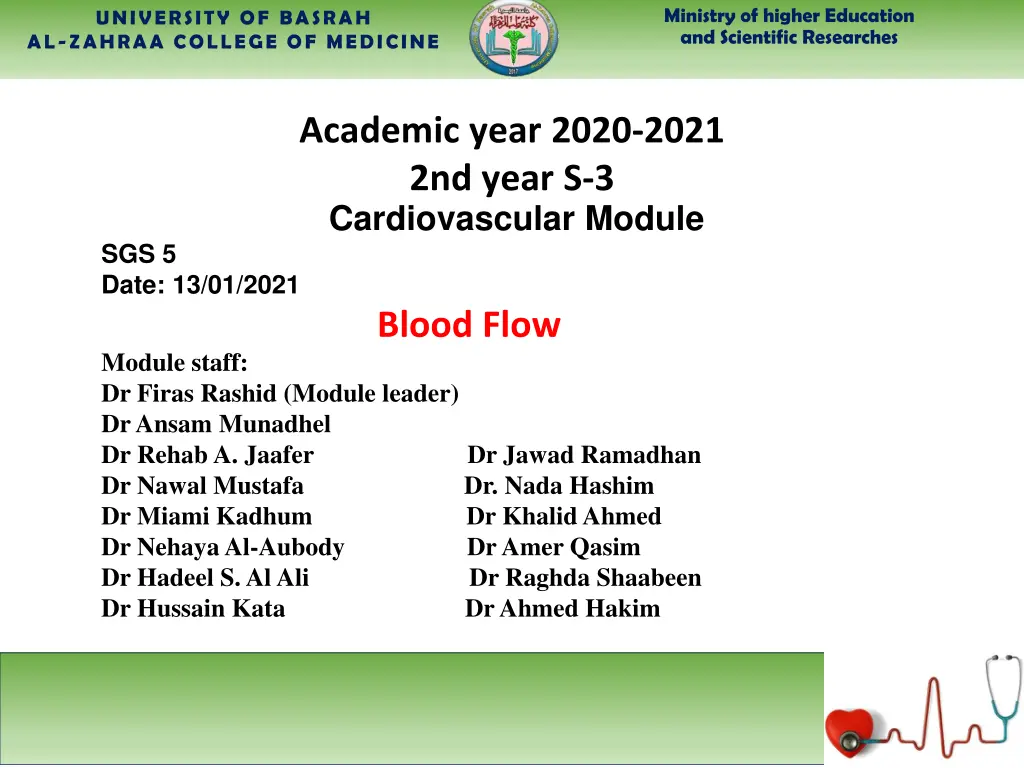
Cardiovascular Module at University of Basrah Al-Zahraa College of Medicine
"Explore key topics from the Cardiovascular Module, including blood flow, viscosity, resistance, and vessel distensibility. Learn about measuring arterial pressure and the circulation system. Join the academic journey in understanding cardiovascular health and function."
Download Presentation

Please find below an Image/Link to download the presentation.
The content on the website is provided AS IS for your information and personal use only. It may not be sold, licensed, or shared on other websites without obtaining consent from the author. If you encounter any issues during the download, it is possible that the publisher has removed the file from their server.
You are allowed to download the files provided on this website for personal or commercial use, subject to the condition that they are used lawfully. All files are the property of their respective owners.
The content on the website is provided AS IS for your information and personal use only. It may not be sold, licensed, or shared on other websites without obtaining consent from the author.
E N D
Presentation Transcript
Ministry of higher Education and Scientific Researches UNIVERSITY OF BASRAH AL-ZAHRAA COLLEGE OF MEDICINE Academic year 2020-2021 2nd year S-3 Cardiovascular Module SGS 5 Date: 13/01/2021 Blood Flow Module staff: Dr Firas Rashid (Module leader) Dr Ansam Munadhel Dr Rehab A. Jaafer Dr Jawad Ramadhan Dr Nawal Mustafa Dr. Nada Hashim Dr Miami Kadhum Dr Khalid Ahmed Dr Nehaya Al-Aubody Dr Amer Qasim Dr Hadeel S. Al Ali Dr Raghda Shaabeen Dr Hussain Kata Dr Ahmed Hakim
Ministry of higher Education and Scientific Researches UNIVERSITY OF BASRAH AL-ZAHRAA COLLEGE OF MEDICINE Q5-5 Is blood more or less viscous than water? Q5-6 Under what circumstances will blood become more viscous? Q5-7 What will happen to the resistance to flow in blood vessels if blood becomes Q5-8 Blood contains cells and plasma, what effect will this have on the way it flows through tubes?
Ministry of higher Education and Scientific Researches UNIVERSITY OF BASRAH AL-ZAHRAA COLLEGE OF MEDICINE Q5-10 If blood is supplied to the tissues of an organ via low resistance arteries feeding high resistance arterioles which vessels will determine how much blood flows if it is supplied at a constant pressure? Q5-11 How will the situation change if the artery is partly occluded?
Ministry of higher Education and Scientific Researches UNIVERSITY OF BASRAH AL-ZAHRAA COLLEGE OF MEDICINE Q5-13 Where, in principle, do you think would be the best place to measure arterial pressure? Why? Q5-14 How would your estimate of arterial pressure differ if you measured it in the arteries of the lower leg of a person sitting or standing up?
Ministry of higher Education and Scientific Researches UNIVERSITY OF BASRAH AL-ZAHRAA COLLEGE OF MEDICINE Q5-20 Which vessels in the circulation are most distensible? Q5-21 What is it about their structure that makes them distensible? Q5-22 Which vessels in the circulation are least distensible?
Ministry of higher Education and Scientific Researches UNIVERSITY OF BASRAH AL-ZAHRAA COLLEGE OF MEDICINE Q5-23 A. If the driving pressure increases, the flow resistance of a distensible tube decreases B. If the driving pressure decreases, the flow resistance of the collapsible tube reaches infinity (i.e. flow stops) whilst the supply pressure is still above zero C. If the driving pressure increases abruptly, the volume of blood contained in a distensible tube will fall D. If the driving pressure suddenly increases, the flow through the tube in the next few seconds will be greater in a more distensible tube E. If the pressure in the fluid surrounding a distensible tube increases, the flow resistance through the tube will increase
Ministry of higher Education and Scientific Researches UNIVERSITY OF BASRAH AL-ZAHRAA COLLEGE OF MEDICINE Q5-24 A. Contraction of the smooth muscle in the walls of a vessel will reduce the diameter of the lumen B. A reduction in lumen diameter produced by contraction of smooth muscle in the walls of a vessel may be reversed if the driving pressure increases C. The curve relating flow to driving pressure in a distensible tube is shifted to the right (i.e. less flow at any given driving pressure) if the smooth muscle in its walls contracts more D. Contraction of smooth muscle in the wall of a distensible tube will lead to critical closure at an elevated driving pressure E. Contraction of smooth muscle in the wall of a highly distensible vessel such as a vein will reduce its capacitance
Ministry of higher Education and Scientific Researches UNIVERSITY OF BASRAH AL-ZAHRAA COLLEGE OF MEDICINE
